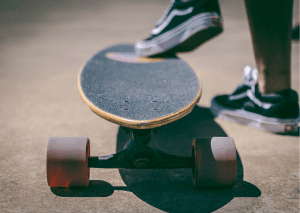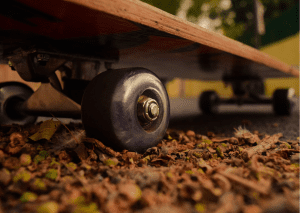We’ve all been there. A prized skateboard, once shiny and new, starts to show the telltale signs of rust. It’s a heart-sinking moment for any enthusiast. Understanding what causes it to rust is the first step toward the prevention of rust.

But don’t despair! At FamilyHype, we’re here to guide you on some tips on rust prevention and keep your beloved board in top-notch condition.
- Choosing the right materials for your skateboard, such as stainless steel, aluminum, and titanium, is crucial to ensure durability and a smooth ride.
- We provide free resources on maintenance, cleaning, and the application of rust protection products to keep your skating experience enjoyable, even in wet conditions.
- Proper storage, such as in a dry and cool place, is equally important, and sometimes, replacing rusty parts is the only way forward.
So, join us as we dive into these methods in detail, empowering you to extend the life of your skateboards while serving our community of skaters who share this common challenge. Let’s preserve our skateboards together because every ride should be as smooth as possible!
Preventing Skateboard Rust
- Understand what the causes are: Rust forms on metal surfaces exposed to water and oxygen, accelerated by factors like humidity, salt, and acidic pollutants.
- Choose the right materials: Opt for stainless steel, aluminum, and galvanized steel for skate parts to prevent rusting.
- Regular maintenance and cleaning: Implement a consistent cleaning schedule using rust protection products to keep the board in top condition.
- Proper storage: Avoid humid and damp areas for storage to prevent rusting.
- Replace parts: Know when it’s time to replace rusted components to maintain a smooth and safe skateboarding experience.
- Safety first: Use the right tools and follow safety measures when replacing parts to avoid injuries.
Skateboard Rust
We understand that preventing rusting on your skateboard is a priority. Before we can help protect your ride, we must first understand what causes it.
- Think of your skateboard parts exposed to water and oxygen, two elements that instigate the formation of rust on metal surfaces.
- Environmental impacts such as humidity, salt, and acidic pollutants can greatly accelerate the rusting process.
- Explore our comprehensive guide to preventing rust for skateboards. Learn how to prevent skateboards from rusting effectively with our top tips, tricks, and the best rust-preventing products.
- We cover everything from understanding the root causes of rusting to the benefits of anti-rusting technology and the importance of a heavy-duty skate bag for safeguarding your gear.
- Discover the best rust prevention tips and where to find the necessary products at your local hardware stores.
Now, let’s explore how the right materials, such as stainless steel, aluminum, and galvanized steel, can help protect your skateboards from this pesky rusting and corrosion.
Prevent Skateboard Rust
Investing in high-quality materials for your beloved skateboards isn’t just about performance, it’s also a crucial step in keeping that dreaded oxidation at bay. As parents and family-focused people, we at FamilyHype understand how important it is to maintain your skateboard for a longer life.

- To choose the right materials for your skateboards, consider opting for stainless steel or aluminum parts for their inherent material durability.
- Additionally, moisture-resistant materials can help keep your deck safe from the elements.
- Coating options like powder coats or zinc finishes can also protect against oxidation, as can rust-resistant bearings.
- Understanding these factors will set us up nicely to discuss regular maintenance and cleaning as another key approach in our fight against rusting.
We hope this article has helped understand the importance of using the right materials for your skateboards. We welcome your feedback and opinions about this article and the skateboarding topic in general.
Skateboard Maintenance
Don’t underestimate the power of regular maintenance and cleaning when it comes to skateboard rust prevention; it’s your secret weapon in keeping that skateboard looking brand new.
- Keep it dry: Moisture is the primary cause of rusting, so try to keep your skateboard dry. Avoid riding your skateboard in wet conditions, and if your skateboard does get wet, dry it off as soon as possible.
- Clean your skateboard after each use: After a skate session, take a few minutes to clean your skateboard.
- Inspect for any damage: Regularly inspect your skateboard for any signs of damage or wear.
- Use a cleaner designed for longboards: There are skateboard-specific cleaning products available.
Here are some of the maintenance tips and ideas that you want to know. We added more to get to know deeper about the maintenance and after care you should have for your board.
- We recognize the importance of a consistent maintenance schedule for lasting longevity. Implement effective cleaning techniques, such as gentle scrubbing and drying, to prevent water damage.
- Don’t forget to use rusting protection products for added safeguarding. It’s not only about fixing problems but also preventing them.

With regular cleaning and maintenance, you can keep your skateboard in top condition.
Rust Prevention
Applying Rust Protection Products to your skateboard’s metal components can be a game-changer for those who rely on the skateboard’s longevity. Here are more tips for skateboard rust prevention.
- For optimal results, we recommend selecting the right products and honing your application techniques. Additionally, proper storage is key to preventing rust development.
- We understand how important it is to take care of skateboards, and we encourage our readers to share their feedback and experiences with us. If you have any questions or comments, please let us know!
- Skateboards are comprised of a variety of entities such as decks, trucks, bearings, wheels, and hardware, all of which should have protection applied to last.
- By taking the necessary steps to apply skateboard rusting prevention products, you can ensure your skateboards remain in tip-top shape for longer.
We hope these tips help you extend the life of your skateboard and provide hours of enjoyment for your family.
Storing Skateboard Properly To Prevent Rust
Ensuring your skateboard’s longevity isn’t just about the parts and components you use, but also where you store it after your ride. At FamilyHype, we understand the importance of proper storage of skateboards.
- The climate is a factor to consider; try to avoid humid and damp areas as they can cause rusting. After every ride, inspect your skateboard for any signs of rusting and take appropriate action if you find any.
- Keeping up with these steps will help to extend your skateboard’s lifespan and improve its performance. You can also save a lot of money in the long run.
Now let’s look at how to handle instances when rusting has already set in.
Replace Rusty Skate Parts
You’ve got to know when it’s time to replace those skateboard parts, not just for a smooth ride but also for your safety.
- Keep an eye out for wear indicators like rusty sides or cracks, and pay attention to any performance impact. If your skateboard isn’t handling as smoothly or responding as quickly, it may be time to change out the skateboard deck, trucks, wheels, and bearings.
- These components are essential for a successful skateboarding experience and, for that reason, should be replaced when they start to show signs of wear.
Sharing your skateboard replacement stories with other FamilyHype readers can be helpful when making decisions on when to change these parts.
Replace Rusty Skateboard Parts Regularly
Having identified when to replace rusty parts, let’s now focus on how to safely swap them out.
Tool selection is critical; using the right ones not only makes the job easier but also safeguards us from potential injuries. Remember to follow safety measures at all times.
By following these steps and keeping safety in mind, we can safely replace our skateboard parts and enjoy the ride for years to come.
Conclusion
At FamilyHype, we understand the importance of skateboards and want to share our knowledge of how to prevent rusting in skateboard parts. We all know the unsightly appearance of rust and the potential safety issues that come with it.
- To begin with, it’s essential to understand what causes rusting. Choose the right materials for your skateboards and their parts, such as aluminum, stainless steel, and titanium, as they’re all more resistant to rusting.
- Additionally, maintaining regular cleaning routines and applying rust-prevention products can help to keep your skateboard in tip-top shape.
- Lastly, make sure to store it properly and replace any rusty parts immediately.
We hope that these tips help you to keep your skateboards in their best condition. Remember, it’s not just about aesthetics; a well-maintained skateboard ensures safety too.
Please feel free to share your feedback, experiences, or opinions about our article with us. Let’s beat the rust together!
Frequently Asked Questions:
Why My Board Has This Discoloration And Ways To Avoid It?
- Your skateboards may be rusting due to exposure to moisture, humidity, or rain. Rusting can develop on the metal parts of the skateboards, such as the trucks, bearings, and bolts if they are not adequately protected.
How To Prevent Rusting And How To Preserve Your Skateboard?
- To preserve your skateboards and prevent rusting, keep it away from moisture and store it in a dry, cool place. Regularly clean and inspect the metal parts, and apply a protective coating or lubricant to create a barrier against rusting.
How Do You Remove Rusting From A Skateboard?
- To remove it, you can use a combination of white vinegar, lemon juice, and baking soda. Apply the mixture to the rusty areas, scrub with a brush, and then rinse thoroughly with water. Dry the skateboard completely afterward.
How Do You Not Ruin A Skateboard?
- To avoid ruining your skateboards, treat them with care and avoid exposing them to harsh elements. Always land tricks properly to minimize stress on the deck. Additionally, regularly inspect and maintain your skateboards, keeping them clean and free from debris.
Should I Oil My Skateboard?
- Yes, you can oil your skateboards to keep their moving parts functioning smoothly. Use skateboard-specific lubricants like skate oil or bearing oil and apply a few drops to the bearings for optimal performance.
Should I Grease My Skateboard?
- While grease may work for certain parts of your skateboards, such as the trucks, it is generally not recommended for the bearings. The bearing of skateboards requires a lighter lubricant like skate oil or speed cream to ensure smooth rolling.
Can I Use WD-40?
- No, using WD-40 on your skateboards is not recommended. While it may temporarily lubricate the bearings, it is not designed for long-term use and can attract dust and debris, leading to decreased performance.
Can You Sharpen A Rusty Skate?
- Sharpening a rusty skate is not advisable. Instead, focus on removing the rusty parts and properly maintaining the skate’s blades to ensure their longevity and performance.
How Do You Keep Paint On A Skateboard?
- To keep paint on skateboards, start with a clean and dry deck surface. Use acrylic or skateboard-specific paint, and apply a primer for better adhesion. After painting, allow sufficient drying time, and consider applying a clear sealer to protect the artwork.
Can Skateboard Bearings Rust?
- Yes, bearings of skateboards can rust, especially if they come into contact with moisture or water. Regular maintenance, proper storage, and the use of lubricants can help prevent rusting on the bearings.
